Supreme Court Set To Hand Down Several Landmark Decisions By End Of June
With one month to go in its term, there's still a lot on the Supreme Court's plate.
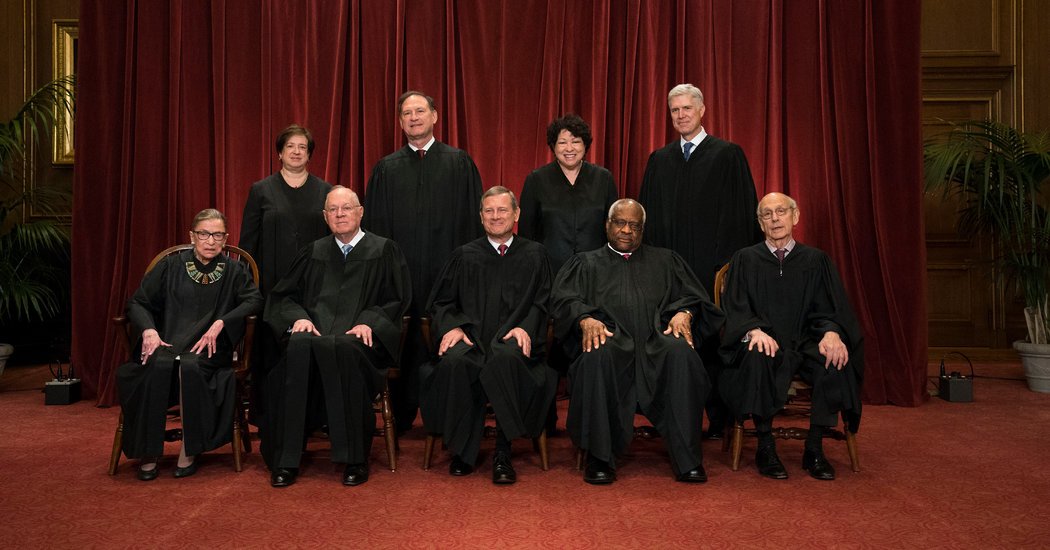
Within the next month, the Supreme Court will hand down the remainder of the decisions that are still pending from the arguments it has heard over the course of the term that began back in October. Unlike the preceding term, this term saw the Court with a full complement of nine Justices, meaning that we’re not likely to get many, if any, of the inconclusive tie votes that we saw during the October 2016 term due to the fact that Justice Gorsuch was not confirmed until April of last year and thus was not present for most of the cases that the Court heard that term. As is usually the case, many of the most contentious cases have not had opinions released, but that is expected to change, perhaps starting as early as this morning when the Court is scheduled to deliver opinions.
By way of review, here’s a review of some of the major cases that the Court will be deciding over the course of the next month.
Political Gerrymandering
One of the major themes that the Court dealt with this term has centered on the issue of voting rights generally, and the manner in which Congressional and state legislative districts are drawn in particular. In the second category, the Court has heard two major cases dealing with the issue of partisan gerrymandering, in which districts are created for the purpose of protecting partisan interests and making it more difficult for opposing parties to challenge incumbents. The first case, Gil et al v. Whitford et al, arises out of Wisconsin and concerns the entire state map, which the Plaintiffs in the case contend was unfairly drawn to benefit Republicans. Among the primary pieces of evidence that the Plaintiffs relied upon in support of their arguments was a somewhat complex mathematical algorithm that purports to find that Wisconsin’s Congressional districts are far more heavily biased in favor of the GOP than should be expected if the district lines were drawn with geographic contiguity and other concerns in mind.
The second case is titled Benisek et al v. Lamone et al and deals with how the lines for a single Congressional District in western Maryland were drawn after the 2010 census. This district had been previously represented by Republican Congressman Roscoe Bartlett but fell into Democratic hands after Bartlett retired in no small part due to the fact that the partisan makeup of the district had become far more Democratic than it was in the past. The Plaintiff’s in Benisek contend that this was done to limit Republican representation in Maryland’s Congressional District.
As I noted when I wrote about the oral argument in both Gil on the first day of the term in October and in Benisek in March, the Justices appeared divided on the issue of the extent to which Courts should involve themselves in trying to limit the authority of state legislatures to craft legislative districts. As expected, the pivotal vote in these cases is expected to be Justice Anthony Kennedy, who has been sympathetic to arguments such as this in the past but who is also clearly concerned about the idea of the judiciary getting deeply involved in the redistricting process, which would likely be the inevitable result of a decision that was a far-reaching as what these respective Plaintiffs are asking for.
Racial Gerrymandering
In addition to the two cases dealing with partisan redistricting, the Court also heard oral argument in an area in which the courts have far more experience, the question of when redistricting that appears to have a racial impact can be permitted under the Constitution and under the Voting Rights Act. This case is Abbott et al v. Perez et al and deals with two Congressional Districts in Texas that the Plaintiffs contend are drawn in a way to minimize the voting power of minorities. The allegations are specifically alleged with respect to the 27th Congressional District and the 35th Congressional District. The 27th District is currently vacant but was previously represented by former Republican Congressman Blake Farenthold, who resigned due to allegations of sexual impropriety earlier this year. The 35th District, meanwhile, is a newly created district that is presently represented by Democratic Congressman Lloyd Doggett. The 37th District Has been criticized as one of the most extreme examples of Gerrymandering in the United States. If the Court decides for the Plaintiffs, it could mean that the Texas legislature would be required to redraw all of the districts for the state.
As I noted when I wrote about the oral argument in this case, this once again appears to be a case where Justice Kennedy will end up being the deciding vote. As with the partisan gerrymandering cases, it’s unclear from the oral argument which way the Court is leaning, but it seems likely that the Plaintiffs here may have more luck before the Court than the Plaintiffs in Gill or Benisek given the already existing precedent on this issue. Notwithstanding that fact, though, we won’t know for sure until the decision is handed down.
Ohio Voter Purge Law
Rounding out the cases before the Supreme Court dealing with voting rights is Husted v. A. Philip Randolph Institute, which deals with challenges to an Ohio law that gives the Secretary of State the authority to remove people from the voter rolls if they have not voted in a number of years and fail to respond to notices from the government regarding their status on the voting rolls. As I noted when the case was argued in January, the Court appeared to be highly divided on the extent to which the Ohio law goes too far in fulfilling a purpose that all the members of the Court seemed to agree was, at least to some degree, entirely legitimate. Because of that, it’s hard to predict exactly where the Court will come down in this case. It could end up being a close 5-4 or 6-3 decision, or it could end up being very one-sided. This is one that we’ll just have to wait and see what happens.
Technology and the Fourth Amendment
In Carpenter v. United States, the Court is being asked to decide whether police are required to obtain a search warrant before they obtain data from a cellphone company that would allow them to track an individual’s movements over a period that could last for days or weeks. This is particularly relevant in the modern era given the fact that virtually all phones come with technology that not only makes it possible to use cell phone tower location to determine someone’s location, but also has a connection to the Global Positioning System that uses satellite data that can typically provide an exact location for the phone in question and, most probably, its user. The defendant in this case, as well as privacy advocates on both sides of the aisle, argue that a search warrant is required, and some states such as California already have laws that require a warrant in these situations for state and local law enforcement. Law enforcement authorities, on the other hand, argue that they need the data in what has become an increasingly complex criminal world. In the oral argument in this case in November, the Justices appeared skeptical of the government’s argument in favor of the idea that no warrant should be required, but they also appeared at least somewhat unsure of the Defendant’s position that a warrant should be required in all circumstances.
State Taxation Of Internet Sales
One of the biggest issues that has arisen with the expanding scope of sales over the Internet has been the extent to which states can require out-of-state sellers to collect sales taxes on merchandise shipped to people residing in their borders. At the present time, the state of the law is controlled by two decisions that stretch back to well before the Internet existed. The first decision was handed down in 1967 in National Bellas Haas v. Department of Revenue. In that case, the Court ruled that a mail-order catalog business was not required to collect sales tax on behalf of states in which it does not have a physical presence. Twenty-six years later, the Court ruled in 1993 in Quill Corp. v. South Dakota in a manner that somewhat overruled the central holding of Bellas Haas but did not completely throw the precedent out. Specifically, the Quill ruling still established that the Commerce Clause prevented states from requiring businesses without an in-state physical presence from collecting sales taxes. Now, the Court is being asked to revisit that issue.
In South Dakota v. Wayfair, Inc., the Court is being asked to revisit its decisions in Bellas Haas and Quill in the light of the rise of the Internet as a huge market for interstate commerce. The Court heard oral argument in the case in April, and by the end of the hearing, it was entirely unclear where the Court might come down on this issue. On the one hand, many Justices appeared sympathetic to the idea that the court’s earlier precedents simply don’t make sense in the modern era. On the other, there was some proper concern over the question of the extent to which a broad ruling in favor of the states could impact a wide variety of issues arising under the Interstate Commerce Clause. As a result, it’s entirely unclear where the Court will end up in this case.
Abortion And The First Amendment
In National Institute of Life and Family Advocates Et Al v. Becerra Et Al, the Justices are being asked to deal with a challenge to a California law that requires Crisis Pregnancy Centers, which are generally run by religious pro-life groups, to provide information about abortion even if they don’t provide them or refer clients to physicians who perform them. The Plaintiffs in the case contend that this law is a violation of the First Amendment in that it is a form of “forced speech” by the state, while California counters that the law is simply meant to ensure that women get the information they need to make an informed decision. During oral argument of this case in March, the Justices appeared to be skeptical of the state’s arguments and appeared ready to strike down the law. The interesting thing to see about this case, then, will likely be to see how the Court’s liberals, who are generally protective of abortion rights, end up going in this case given the obvious First Amendment concerns.
Trump Travel Ban
In Trump v. Hawaii, the Court is being asked to review a ruling from the Ninth Circuit Court of Appeals that struck down the third and final iteration of the travel ban that the Trump Administration had put in place shortly after Inauguration Day. The history behind this ban is well known, so I won’t repeat it here. As it stands, though, it appears clear from the oral argument that the Court heard near the end of April that the challengers could be on the verge of being handed a defeat, or that at the very least the Court is likely to rule that the President does have the authority under the law to ban people from specific countries if he deems it to be necessary for national security. What will be interesting to see is whether the Justices deal with the issue of whether or not the President’s tweets and campaign statement, as well as the statements made by advisers and supporters, can properly be considered by Courts in situations such as this.
Public Sector Unions
In Janus v AFSCME et al, the Court is being asked to once again examine an issue that it heard prior to the death of Justice Scalia but was unable to issue a conclusive opinion due to the fact that he had died prior to the time the decision was handed down. At the heart of the case is the Court’s ruling in a 1977 case styled Abood v. Detroit Board of Education in which the Court essentially legalized the “closed shop” for public sector employees, meaning that an employee for a local, state, or Federal agency or department could be required to join a union and pay dues as a condition of employment. For years, critics of forced unionization sought to overturn Abood, but it has only been with the rise of the current largely conservative Supreme Court that they have been successful in their efforts.
That opportunity came in the October 2015 term in Friedrichs v. California Teacher’s Association, which the Court accepted for review at the end of its October 2014 Term. When the Court heard the case in January 2016, it appeared that there was at least a 5-4 majority ready to overturn Abood and rule the collection of mandatory union dues unconstitutional. Within a month after oral argument, though, Justice Antonin Scalia died and the Court was left with a split that ended in a 4-4 ruling that allowed the Ninth Circuit Court of Appeals decision upholding the fees to stand but left both sides of the debate somewhat disappointed at the lack of a final resolution of the matter. Now, with the Janus case and the presence of Justice Gorsuch on the Court, the fate of public sector employee unions appears to be rather grim.
When the Court heard oral argument in Janus back in February, the conservative majority, including Justice Kennedy, appeared to be united in the position that the Abood ruling was flawed and that the First Amendment barred public employee unions from requiring employees to pay dues to keep their jobs. As I’ve said before, it’s fairly well-settled law, that people cannot be forced to subsidize speech they disagree with, and as the court’s conservative Justices noted in their questioning, the argument that there can be a distinction between public advocacy and contract negotiation in a public employee context simply doesn’t make any sense. Given this, a public employee who is compelled to pay union dues as a condition of employment is being compelled to subsidize speech whether they want to or not. This would seem to be a clear violation of the First Amendment.
Gay Rights And First Amendment
It has been three years since the Supreme Court handed down the ruling in Obergefell v. Hodges, which struck down the remaining laws barring same-sex marriage that still existed around the country. While this has largely meant the end of the debate over same-sex marriage in the United States, it has also given rise to a number of related issues that will likely take some time to resolve. One of those issues involves the conflict between laws that proscribe discrimination based on sexual orientation and claims by owners and operators of businesses, especially businesses that provide wedding-related services, that their First Amendment religious liberty rights are being violated. Previously, the Court had declined to hear a number of these cases, including one arising out of New Mexico dealing with the claims of a photographer who had refused to provide services for a same-sex wedding that had been rejected by the Supreme Court of New Mexico.
Last June, though, the Justices agreed to hear Masterpiece Cakeshop v. Colorado Civil Rights Commission, a case dealing with a baker in Lakewood, Colorado who refused to bake a cake for a same-sex wedding based on his religious beliefs. This led the couple to whom he had refused service to file a complaint with the Colorado Civil Rights Commission, which issued a ruling against the baker and imposed fines and other punishments based upon the state’s public accommodations law, which bars discrimination based on sexual orientation. As with a number of the other cases described here, as well as the majority of the Supreme Court’s cases dealing with LGBT rights, it’s likely that the outcome of this case will depend on where Justice Kennedy comes down.
On one side of the equation, there are a number of Supreme Court precedents dating back more than a decade in which Kennedy has played the decisive role in moving the case law protecting gay and lesbian Americans forward. This started in Romer v. Evans, a case in which the Court struck down a Colorado referendum that purported to bar local jurisdictions from passing municipal laws barring discrimination against its LGBT citizens. It continued in Lawrence v. Texas, a 2003 case which overturned the Court’s previous ruling in Bowers v. Hardwick and found state and local laws barring consensual sodomy to be unconstitutional. When the legal battle for marriage equality reached its peak earlier this decade, Kennedy was once again the key vote in advancing LGBT rights. In United States v. Windsor, Kennedy wrote the majority opinion in the case in which the Court found the Defense of Marriage Act to be unconstitutional. Finally, of course, it was just over two years ago that Kennedy penned the majority opinion in Obergefell v. Hodges, the case that struck down laws against same-sex marriage in the states where they remained standing.
On the other side of the equation lies religious liberty claims under the First Amendment, which is also an area where Justice Kennedy has been particularly protective. Two cases, however, appear to provide some clue as to where the Court might be headed. The first case was one handed down in 2011 styled Christian Legal Society v. Martinez. In that case, the Court rejected a claim by a conservative student organization challenging a policy by the University of California Hastings College of Law that barred officially sanctioned student organizations from discriminating in membership and other policies based on a prospective member’s status or beliefs. Kennedy joined a majority in that case in an opinion written by Justice Ginsburg and filed his own concurring opinion. The student organization had argued that its Christian beliefs were sufficient justification for barring prospective members who engaged in “unrepentant homosexual conduct” or otherwise supported ideas such as same-sex marriage or LGBT rights. In his concurrence, Kennedy specifically argued that the interest in barring discrimination outweighed the First Amendment rights of the student organization. The second case is a 2017 case called Expressions Hair Design v. Schneiderman in which a unanimous Supreme Court held that a law “does not violate the First Amendment because it has an effect on speech that is “only incidental to its primary effect on conduct.”” In this case, that would mean that even if there is a valid freedom of speech claim being made by the baker, it does not trump a generally applicable law barring discrimination that clearly has only an incidental impact on those claims. It was hard to draw a conclusion from the oral argument in this case when it was held in December of last year, but these precedents suggest that the baker’s claims may not fare very well in the end.
And, also…..
Hanging over all of this, of course, is the potential that we could learn between now and the end of the term that one or more of the Justices is retiring. This would be the first retirement since John Paul Stevens announced his retirement in 2010 and was replaced by Justice Elena Kagan and the first Court vacancy since Justice Anton Scalia died in 2016 and was replaced by Justice Neil Gorsuch in 2017. The most talked-about potential resignation, of course, is that of Anthony Kennedy, who has been on the Court since February 1988 and is currently the longest-serving Justice on the Court. Kennedy was at the center of retirement rumors for two years now and has given no indication of his intentions so far. Given his frequent role as the balance between the Court’s liberal and conservative wings, a Kennedy resignation would be hugely consequential for the future direction of the Court. Another potential retirement that some in Washington have whispered about is Justice Clarence Thomas, who is still relatively young at 68 and, many have suggested, could be at the point where he’d like to spend his remaining years with his wife and family. Most likely, we’d only get one resignation this year, and it’s entirely possible we won’t get any. In the end, we won’t know for sure until the last day of the term roughly a month from now.

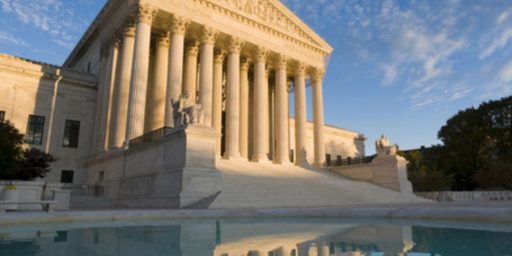
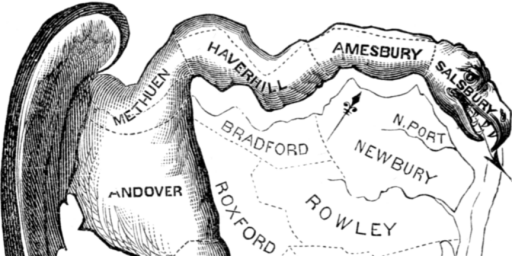
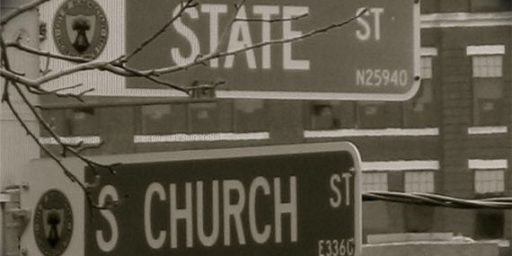

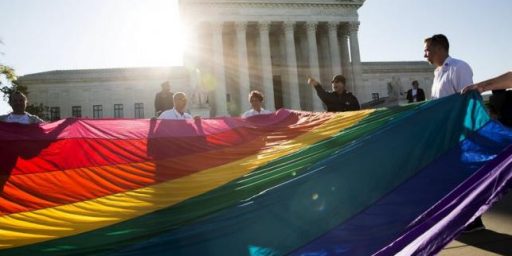
Care to make any guesses on how these cases will be decided? Also, in what cases will the decisions be unanimous, 8-1, or 7-2?
@Dave Schuler:
The only case I’m pretty much certain on is the Janus case on public employee unions. It was already apparent when the last case on this issue was argued in January 2016 that there were five votes (Roberts, Kennedy, Scalia, Thomas, and Alito) to overrule Abood. The only thing that prevented that was Justice Scalia dying in February 2016, meaning that his vote on the case no longer counted. With Justice Gorsuch in his case, it seems likely that we’ll end up with the result that we would’ve gotten in the 2016 case if Scalia had lived. That’ll be a 5-4 case.
The other cases — particularly the partisan Gerrymandering cases and the LGBT rights/Christian baker case — are harder to forecast, at least for me. Several of them will depend on where Kennedy falls.
I also expect the Court will largely uphold the travel ban along 5-4 lines.
The rest? Your guess is as good as mine.
If the Court strikes down the California law National Institute of Life and Family Advocates Et Al v. Becerra Et Al, and rules that Prenancy Crisis Centers cannot be compelled to give information about abortion, will this have any effect on the laws in other states where doctors are required to give their patients false information about the links between abortion and breast cancer?
What about requiring a medically unnecessary ultrasound?
@Gustopher:
Depending on the ruling, it could have an impact on those situations but it would require someone to challenge the laws in question.
@Gustopher:I’d take is a step further.
If Doug is right here that the Court will find this a First Amendment violation, than all the executive orders and laws that condition funding on not providing abortion counseling are going to be tee’d up to be overturned as well. The “Global Gag Rule” has similar problems from a speech perspective – perhaps worse as it involves denial of access to federal funds and services – as does the ban on funding to Planned Parenthood…